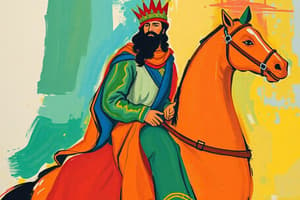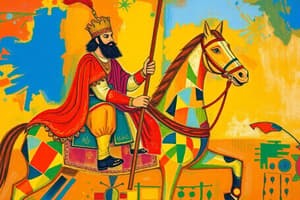Podcast
Questions and Answers
What was the primary motivation behind Ghiyasuddin Balban's implementation of the 'blood and iron' policy, along with practices such as 'Sijda' and 'Paibos'?
What was the primary motivation behind Ghiyasuddin Balban's implementation of the 'blood and iron' policy, along with practices such as 'Sijda' and 'Paibos'?
- To encourage cultural exchange and integration between different communities within the Delhi Sultanate.
- To promote religious tolerance and understanding among the diverse religious groups in his kingdom.
- To foster economic growth and development by attracting foreign traders and investors to the region.
- To consolidate his authority and assert his supremacy as the ruler of the Delhi Sultanate. (correct)
How did Iltutmish consolidate and legitimize the Slave Dynasty's rule in the Delhi Sultanate?
How did Iltutmish consolidate and legitimize the Slave Dynasty's rule in the Delhi Sultanate?
- By shifting the capital from Lahore to Delhi and effectively managing Mongol threats. (correct)
- By promoting local Hindu traditions and customs within the court.
- By focusing solely on military conquests and territorial expansion, neglecting administrative reforms.
- By forming alliances with other Turkish rulers and integrating their administrative systems.
Razia Sultan's reign was notably short. Which combination of factors primarily contributed to her downfall?
Razia Sultan's reign was notably short. Which combination of factors primarily contributed to her downfall?
- Her successful expansionist policies, which led to overextension of administrative power and resources.
- Her gender, combined with the resistance from the Turkic nobles (Turkani Chahalgani) and political instability. (correct)
- Her implementation of economic reforms that led to widespread discontent among the peasant population.
- Her exclusive focus on architectural achievements, neglecting military and defense concerns.
What was the significance of Balban's destruction of the 'Turkani Chahalgani' (The Group of 40 Nobles), and how did he maintain control over his officials?
What was the significance of Balban's destruction of the 'Turkani Chahalgani' (The Group of 40 Nobles), and how did he maintain control over his officials?
Which statement best describes the lasting legacy or overall importance of the Slave Dynasty in the context of the Delhi Sultanate?
Which statement best describes the lasting legacy or overall importance of the Slave Dynasty in the context of the Delhi Sultanate?
Which of the following statements accurately describes a consequence of the Second Battle of Tarain in 1192 AD?
Which of the following statements accurately describes a consequence of the Second Battle of Tarain in 1192 AD?
Qutub-ud-din Aibak is known for initiating several constructions. Which of the following structures did he NOT complete?
Qutub-ud-din Aibak is known for initiating several constructions. Which of the following structures did he NOT complete?
How did Iltutmish consolidate his rule and legitimize his dynasty in the Delhi Sultanate?
How did Iltutmish consolidate his rule and legitimize his dynasty in the Delhi Sultanate?
Which of the following is true regarding Qutub-ud-din Aibak's reign?
Which of the following is true regarding Qutub-ud-din Aibak's reign?
Iltutmish is often referred to as the 'real founder' of the Delhi Sultanate's Slave Dynasty. Which action best supports this claim?
Iltutmish is often referred to as the 'real founder' of the Delhi Sultanate's Slave Dynasty. Which action best supports this claim?
Which of the following statements correctly identifies a difference between the reigns of Qutub-ud-din Aibak and Iltutmish?
Which of the following statements correctly identifies a difference between the reigns of Qutub-ud-din Aibak and Iltutmish?
The 'Iqta System' was an important feature of the Delhi Sultanate. What was its primary purpose under Iltutmish?
The 'Iqta System' was an important feature of the Delhi Sultanate. What was its primary purpose under Iltutmish?
Muhammad Ghori's military campaigns significantly impacted the political landscape of northern India. Which of the following is the LEAST accurate description of these campaigns?
Muhammad Ghori's military campaigns significantly impacted the political landscape of northern India. Which of the following is the LEAST accurate description of these campaigns?
Flashcards
Third Battle of Tarain: Year?
Third Battle of Tarain: Year?
Iltutmish defeated Taj al-Din Yildiz.
Razia Sultan
Razia Sultan
First Muslim woman to rule India; ruled for four years (1236-1240 AD).
Balban's Rule
Balban's Rule
Policy of harsh punishment to maintain control; system of 'Paibos' and 'Sijda'.
Turkani Chahalgani
Turkani Chahalgani
Signup and view all the flashcards
Iltutmish: Capital Shift
Iltutmish: Capital Shift
Signup and view all the flashcards
Muhammad Ghori
Muhammad Ghori
Signup and view all the flashcards
Battle of Chandawar
Battle of Chandawar
Signup and view all the flashcards
Qutub-ud-din Aibak
Qutub-ud-din Aibak
Signup and view all the flashcards
"Lakh Baksh"
"Lakh Baksh"
Signup and view all the flashcards
Qutub Minar
Qutub Minar
Signup and view all the flashcards
Tughlaq Dynasty
Tughlaq Dynasty
Signup and view all the flashcards
Iltutmish
Iltutmish
Signup and view all the flashcards
Iltutmish's currency
Iltutmish's currency
Signup and view all the flashcards
Study Notes
Muhammad Ghori's Invasions
- Muhammad Ghori initiated invasions into India in 1175 AD.
- Prithviraj Chauhan defeated Ghori in the First Battle of Tarain in 1191 AD.
- Ghori defeated and killed Prithviraj Chauhan in the Second Battle of Tarain in 1192 AD.
- King Bhimdev II was the first Rajput king to defeat Muhammad Ghori.
- Muhammad Ghori died on March 15, 1206.
- Multan & Sindh were conquered from 1175-1178 AD.
- The Battle of Chandawar occurred in 1194 AD, fought between Ghori and Jaichand Rathore, who was Prithviraj Chauhan's father-in-law.
- Conquest of Gujarat, Bundelkhand, Bengal, and Bihar occurred between 1195-1202 AD.
- The Khokhar revolt took place in 1205 AD.
Slave Dynasty Rulers
- Qutub-ud-din Aibak ruled from 1206-1210.
- Aram Shah succeeded Aibak.
- Iltutmish ruled from 1210-1236.
- Razia Sultan ruled from 1236-1240.
- Ghiyas ud din Balban was also a ruler.
Qutub-ud-din Aibak
- Muhammad Ghori entrusted his Indian empire to Qutub-ud-din Aibak when returning.
- Aibak, a slave and commander of Ghori, was also regarded as his son-in-law.
- Qutub-ud-din Aibak was known as "Lakh Baksh" due to his generosity and donations of lakhs.
- Aibak did not assume the title of Sultan, referring to himself as Malik and Sipahsalar, considering himself a slave of Ghori.
- While he founded the Slave Dynasty, Iltutmish is seen as the dynasty's real founder.
- He constructed the Adhai Din Ka Jhopra in Ajmer and the Quwwat-ul-Islam Mosque in Delhi.
- In Delhi, he began construction of the Qutub Minar to honor Sufi saint Khwaja Qutbuddin Bakhtiyar Kaki.
- Aibak was of Turkish origin.
- He governed from 1206 to 1210 AD.
- He died in 1210 AD while playing Chaugan (Polo).
- Fakhruddin, the writer of 'Tareekh-e-Mubarak Shahi', lived during his reign.
Delhi Sultanate
- The Delhi Sultanate comprised five dynasties.
- The Tughlaq Dynasty was the longest.
- The Khilji Dynasty was the shortest.
- The Slave Dynasty existed from 1206 to 1290 AD, lasting 84 years.
Iltutmish
- Iltutmish reigned from 1210-1236 AD.
- His original name was Shamsuddin Ilyas.
- He was an Ilbari Turk from the Shamsi dynasty.
- Iltutmish finished the construction of Qutub Minar.
- In 1229 AD, the Caliph of Baghdad legally recognized Iltutmish as the Sultan of Delhi.
- He moved the capital from Lahore to Delhi.
- He established the "Turkan-i-Chahalgani," a group of 40 nobles.
- Iltutmish was known as the Slave of Slave.
- He introduced two coins: the silver coin (Tanka) and the copper coin (Jital).
- Iltutmish initiated the 'Iqta System,' which divided the empire into small tracts (Iqtas) assigned to soldiers and officers.
- The Third Battle of Tarain in 1216 AD was between Iltutmish and Taj al-Din Yildiz, with Iltutmish winning.
- Minhaj-us-Siraj, author of 'Tabaqat-i Nasiri', lived during his reign.
Razia Sultan
- Razia Sultan was the first Muslim woman to rule India, and daughter of Iltutmish.
- She ruled for four years (1236-1240 AD).
- Yakut was her slave.
- She married Altunia, the governor of Bhatinda.
- Razia and Altunia died in 1240 near Kaithal, Haryana.
- The Turkani Chahalgani, a group of 40 nobles/Turkish leaders, did not accept a woman ruler.
Ghiyasuddin Balban
- Balban initiated the "blood and iron" policy.
- Balban implemented the systems of "Paibos" and "Sijda" to assert his authority.
- "Paibos" is the persian word for kissing feet and "Sijda" involves bowing before the ruler.
- Balban gave himself the title "Zil-i-Ilahi," meaning Shadow of God.
- Balban introduced the festival of Navroz of Parsi origin in India.
Balban's Policies
- Balban dismantled the Turkani Chahalgani (group of 40).
- Balban appointed spies to monitor his officials.
- He created a military department called "Diwan-i-Arz."
End of Slave Dynasty
- The last ruler of the Slave Dynasty was either Kaikubad or his minor son, Kayumars.
- Jalaluddin Firuz Khilji, who founded the Khilji dynasty, assassinated Kayumars.
Mongol Invasion
- Genghis Khan attacked the Delhi Sultanate during Iltutmish's reign.
- Genghis Khan founded the Mongol Empire.
Slave Dynasty Overview
- Qutub-ud-din Aibak founded the Slave Dynasty in 1206.
- The Slave Dynasty was the first dynasty of the Delhi Sultanate.
- Aibak constructed mosques like Quwwat-ul-Islam Mosque in Delhi and Adhai Din Ka Jhopra in Ajmer.
- Iltutmish relocated the capital from Lahore to Delhi.
- Raziya Sultan was the first and last Muslim woman to rule over Delhi.
- Ghiyasuddin Balban eliminated the Turkani Chahalgani, introduced the Sijda and Paibos systems, and initiated the Navroz festival.
Studying That Suits You
Use AI to generate personalized quizzes and flashcards to suit your learning preferences.




